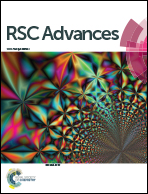Mechanical and tribological characteristics of carbon nanotube-reinforced polyvinylidene fluoride (PVDF)/epoxy composites
Abstract
In this study, epoxy (EP) composites filled with different contents of polyvinylidene fluoride (PVDF) and carbon nanotubes (CNTs) were fabricated by the solvent evaporation and curing method. FT-IR and XRD analysis were performed to explore the discolorment mechanism of the PVDF/EP composites before and after curing. The effects of the PVDF and CNT content on the mechanical and tribological properties of the composites were investigated. Results revealed that 1.0% CNT/30% PVDF/EP composites exhibited a 36.2% and 10.1% increase in flexural strength and hardness, as compared to those of the 30% PVDF/EP composites. The wear rates of 1.0% CNT/30% PVDF/EP composites and 30% PVDF/EP composites were 92.1% and 86.8% lower than that of pristine EP under 1.0 MPa and 0.76 m s−1, respectively. Meanwhile, the fractured and worn surfaces of specimens were both analyzed by the observations of SEM. In addition, wear tests under various applied loads were conducted for pristine EP, 30% PVDF/EP and 1.0% CNT/30% PVDF/EP composites. The results showed that the wear properties of the two composites were both superior to those of pristine EP due to the formation of a transfer film as revealed by SEM-EDS analysis, which could effectively protect the worn surface from direct abrasion during the wear testing.


 Please wait while we load your content...
Please wait while we load your content...